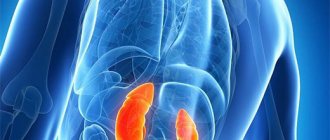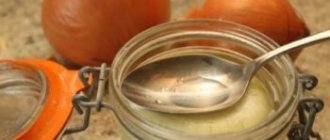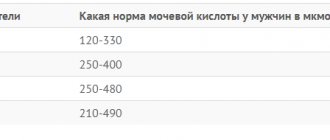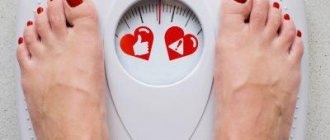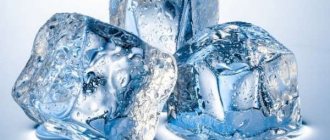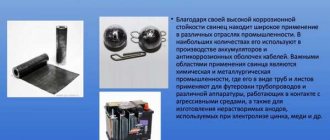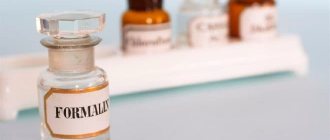Disruption of metabolic processes in the body contributes to the appearance of sand in the kidneys. Such changes are hereditary or acquired. The formation of sand is the first manifestation of urolithiasis (UKD), which causes the development of renal failure and leads to malfunctions of the urinary system.
It is much more difficult to cure such diseases than to remove the formed sand from the kidneys at the initial stage. The composition of sand can be different, depending on the acid salts under the influence of which it is formed.
Types of deposits:
- urate;
- phosphate;
- oxalate.
Sand formation occurs gradually and is almost invisible to the patient. Later, sand begins to come out along with urine, and the person experiences symptoms such as acute pain, fever, and pressure surges.
The essence of pathology
Sand in the kidneys is small crystals of salts that are not excreted in the urine, but settle in the tissues.
This can be facilitated by:
- poor nutrition;
- inflammatory kidney diseases;
- abnormalities of organ development;
- physical inactivity;
- dehydration of the body.
Depending on what salts accumulate, urate, phosphate and oxalate crystals are distinguished. The pathology is usually asymptomatic; when sand moves, minor pain in the lower back may occur.
However, the person needs to be treated, because later the sand forms stones. This manifests itself with more pronounced symptoms and impairs kidney function. Pathology is diagnosed using ultrasound (photo).
Pathology can only be detected using ultrasound
Main symptoms
The danger of urolithiasis is that at the initial stage, the symptoms indicating stones and sand in the kidneys are extremely vague, unclear, and can be confused with other diseases of the urinary system.
- The first stage is the most inconspicuous. The appearance of coarse sand in the kidneys causes aching pain in the lumbar region. As a rule, the right organ suffers (is affected) first, so the pain is felt on this side. Over time, the pain descends in men to the groin area, in women it spreads inside, in the upper abdomen.
- Lower back pain may be accompanied by fever. At this stage, we can assume the development of an inflammatory process, which was provoked by stones/sand in the kidneys.
- Impaired urination is the next stage in the development of inflammation, which should alert a person. The process itself becomes painful. A person has an increased urge to urinate, but not every trip to the toilet ends with emptying the bladder.
- The third stage is a clearly expressed signal. During bowel movements, a person notices a change in the color and smell of urine. The liquid acquires a color approaching brown and becomes cloudy. The smell is pungent, repulsive, unpleasant.
- At the most advanced stages, drops of blood are observed in the urine - stones violate the integrity of the mucous membrane. The most striking symptom is purulent clots in the urine.
Pregnant women, whose kidneys experience additional stress, require special attention. When salt stones form in the urinary ducts, their swelling increases, their blood pressure increases, the feeling of nausea increases, and dizziness appears.
Folk remedies for removing sand from the kidneys
Parsley roots and grass also remove sand from the kidneys. The daily dose is one tablespoon of a mixture of parsley roots and herbs, brewed with 500 ml of boiling water, infused for 2 hours, filtered and taken throughout the day.
- How to dissolve kidney stones using folk remedies
I wrote in the article “Sunflower roots treatment” how to remove sand from the kidneys using folk remedies using such a powerful medicinal plant as sunflower. The article is lengthy, so I won’t rewrite it here, read it yourself. I will add that in addition to sand, it also dissolves kidney stones well.
Another strong medicinal plant that helps get rid of sand in the kidneys is rosehip. The roots of this plant, no younger than 3 years old, are taken and crushed. Next, in the evening, 2 teaspoons of the roots are poured with a liter of boiling water and simmered over low heat for 10 minutes.
Then pour into a thermos for infusion. The next day, they begin to drink half a glass 3 times a day strictly through a straw, so as not to spoil the enamel of the teeth. Afterwards, it is advisable to rinse your mouth with water. Take this decoction for 2 weeks, then take a month off and repeat again.
Treatment of sand in the kidneys
- The red apple recipe is a healthy substitute for tea and coffee. 3 medium red apples are finely chopped, poured with a liter of water, boiled for 15 minutes and infused, wrapped in a bowl, for 2 hours. This compote, which helps remove sand from the kidneys, is drunk all day and every day.
- Black radish juice is mixed with liquid honey in a ratio of 1 to 2. If the honey has thickened, it is liquefied in a water bath. This mixture is taken 1 tablespoon after meals 3 times a day for a month.
We expel sand from the buds with grape leaves
300 g of grape leaves must be washed, dried and crushed. Then fill the jar with 1 liter of clean cold water. Place in a dark place for 3 days to infuse. Then you need to drink half a glass 3 times a day for a month.
Sand in the kidneys, stones and salts: symptoms, treatment, causes, diet and prevention
Sand in the kidneys is one of the first manifestations of urolithiasis.
It may not bother the patient at all until it enlarges to stones and shows itself in all the glory of the unpleasant symptoms of urolithiasis.
This urological disease is very widespread among all age groups, more often affecting men. Read about the various causes, symptoms, treatment and prevention methods in the article.
Dragomilov A.G., Mash R.D. Biology: 8th grade: Textbook for students of general education institutions. — 3rd ed., revised. - M.: VentanaGraph, 2008. - 272 p.: ill.
Sand in the kidneys: symptoms in women and men
Urolithiasis is a typical disease of a modern person who leads an inactive lifestyle and does not monitor nutrition. Gradually, this leads to the appearance of sand in the kidneys. The particle sizes are 2–3 mm. If this stage is advanced, which is what my colleagues - urologists and nephrologists often encounter - then over time kidney stones will make themselves felt.
The first signs of kidney problems appear when sand accumulates in sufficiently large quantities and begins to gradually leave the body. This is indicated by a number of symptoms:
- frequent urge and pain when urinating;
- pain when urinating and in the lower abdomen;
- the appearance of blood in the urine;
- cloudy and dark urine;
- increased swelling.
An increase in temperature, blood pressure, nausea and vomiting is also possible.
Lyubimova Z. V., Marinova K. V. Biology. Man and his health. 8th grade. — M.: Vlados.
Pain in the groin on the right, radiating to the testicle, blood in the urine - in men these are additional signs of the formation of sand and stones. Women may experience a burning sensation in the lower back and a burning sensation when urinating, which can easily be confused with cystitis.
Pain in the kidney area in the presence of sand, as practice shows, rarely occurs. It accompanies renal colic and is usually associated with the advancement of stones.
Sand in the kidneys: treatment
How to remove sand from the kidneys, how to treat the kidneys, what to do if the kidneys hurt, what to drink and who to contact? There are many answers to these questions, as well as a variety of treatment methods today. In addition, they change and are supplemented, as my colleagues P.V. Glybochko, N.A. Lopatkin, Yu.G. Alyaev, N.D. Akhvlediani write about.
Correction of lifestyle and nutrition is the first thing that sand in the kidneys dictates to the patient. What to do besides this?
In clinical practice, kidney treatment with folk remedies has proven itself well. Infusions and decoctions of medicinal herbs have a mild effect, normalize the formation and excretion of urine, and the acid-base balance.
How to cleanse the kidneys and how to treat the kidneys with folk remedies? The simplest methods are:
- drink carrot or grape juice every morning on an empty stomach;
- cut 300 g of apples, pour in 1 liter of water, boil for 10 minutes, then leave for 3 hours. Drink throughout the day;
- in the evening dissolve 1 tsp in 200 ml of water. honey Drink liquid in the morning. Repeat the procedure for two weeks;
- Grate black radish and squeeze out the juice. Mix with honey in a 2:1 ratio. Take 1 tbsp. l. half an hour after eating.
Herbal treatment of kidneys includes the following methods:
- 3 tbsp. l. dried rose hips pour 1 liter of boiling water. Leave for 2 hours, drink throughout the day;
- mix parsley, strawberry leaves, birch buds, flax seeds (1 tablespoon each), chop. Pour 1 liter of boiling water and leave for 24 hours. Drink a glass three times a day;
- take corn silk, calamus, knotweed and lingonberry leaves (1 tbsp each), pour boiling water over it, leave for 1 hour. Before meals drink 100 ml;
- immortelle, madder, motherwort, lingonberry leaves (1 tablespoon each) pour 1 liter of boiling water, leave for half an hour, filter. Drink 100 ml half an hour before meals.
Fir oil also speeds up kidney healing. A few drops can be added to any of the infusions listed above.
Before using these methods, you should remember which doctor treats your kidneys. This is a nephrologist and urologist who will prescribe competent treatment and know what to do in case of renal colic, whether it is possible to warm the kidneys, what to do if the kidneys hurt, how to treat it and how to do it.
For example, renal colic cannot be eliminated using traditional methods. Doctor of Medical Sciences of the Research Institute of Urology of the Ministry of Health of the Russian Federation N.K. Dzeranov calls a complex medical problem a condition where the kidneys hurt. What to do in such a situation must be decided, first of all, by the doctor.
And in my practice there was a case when a patient, without relieving renal colic with folk remedies, started the disease. As a result, surgical treatment had to be used.
Sand in the kidneys: diet
Diet for kidney disease is the first and main remedy that can significantly improve the patient’s condition and well-being. In essence, the kidneys are a filter, and therefore cleansing the kidneys is directly related to reducing the load on them from the outside.
What is good for the kidneys? First of all, let's pay attention to useful universal rules:
- drinking plenty of fluids. The daily volume of fluid should be such that up to 2 liters of urine are formed during the day. In this case, the salt will not have time to precipitate in the form of sand. It is important to drink clean water regularly between meals;
- reducing the consumption of salt (sodium chloride) and sugary carbonated drinks. The more sodium and sugar in the body, the more calcium is excreted. Its excess can form sand in the urinary system;
- adding foods rich in vitamin A to the diet to quickly restore damaged tissue.
Also, the diet for sand in the kidneys directly depends on its type, that is, on the main component. They can be salts of oxalic acid (oxalates), uric acid (urates), and phosphoric acid (phosphates).
Products that are beneficial for the kidneys with oxalate sand:
- those that promote its dissolution are white grapes, quince, pears, dogwoods, apples, plums;
- preventing formation due to the content of magnesium and vitamin B6 - dried fruits, wheat bran, oatmeal, buckwheat, millet, black bread.
Limit the consumption of beets, sorrel, rhubarb, spinach, beans, parsley, zucchini, citrus fruits, celery, red grapes, green beans, gooseberries, figs, blueberries, blackberries. All of these products contain oxalic acid, as do gelatin-containing dishes, which are also contraindicated.
The diet for kidneys with urate sand is as follows:
- limit foods high in uric acid and purines (meat, poultry, yeast, fish, legumes, mushrooms, seafood);
- add alkaline mineral waters, dairy products, sweet fruits, and vegetables to the diet;
- reduce the amount of animal fats and carbohydrates (cream, sour cream, baked goods, sweets), as well as sour berries (cranberries, lingonberries);
- drink drinks with caffeine in doses (no more than 2 cups of tea or coffee per day).
Foods that are beneficial for the kidneys in the presence of phosphate sand are grains, eggs, meat, fish, and sour berries. All of them acidify the urine and help dissolve this type of sand.
Alkalinizing foods (milk, sweet fruits and berries, dairy products), strict vegetarianism, food sources of vitamin D (liver, caviar, etc.) are contraindicated.
Sand in the kidneys: causes, prevention
Where do salts in urine come from, why do concrements, that is, stones, form? From the clinical practice of my colleagues, the following general risk factors are well known:
- poor nutrition;
- sedentary lifestyle;
- bad habits.
Together, they gradually lead to a slowdown in metabolism. Recycled substances, including salts, linger in the urinary system, accumulate and sooner or later manifest themselves as unpleasant symptoms.
In addition, there are specific reasons.
Thus, oxalates in the urine often appear in diseases of the small intestine and pancreas, magnesium deficiency, and excessive consumption of vitamin C (ascorbic acid).
Urates in the urine indicate an acidic environment and accompany obesity, alcoholism, and gout. Phosphate sand is formed in alkaline urine, with pathologies of the skeletal system, hyperfunction of the parathyroid gland.
Accordingly, preventive measures should be primarily aimed at a healthy lifestyle. A proper diet with enough water and adequate physical activity is the key to not only the health of the kidneys, but also the whole body. In addition, it is important to regularly take urine tests and undergo examinations by specialists.
Source: https://www.nur.kz/1736993-pesok-v-pockah-kamni-i-soli-simptomy-lecenie-priciny-dieta-i-profilaktika.html
Features of the disease
How to quickly remove sand from the kidneys? This is a question faced by many people around the world. The disease is often accompanied by pain and various complications. If small formations (diameter up to 2 mm) are passed in the urine, they do not cause significant pain. They are usually called sand. However, small formations may remain in the kidneys without being excreted. As a result, a small stone is formed from a small concrement. It may gradually increase in size.
Some stones are eliminated from the body. As they pass through the urinary tract, the formations scratch their walls. This leads to the appearance of various inflammatory processes and infections. In some cases, stones block the urinary canal. This causes severe pain. Spasms and other unpleasant phenomena appear.
Large stones cannot be eliminated from the body on their own. They need to be broken down into smaller fractions and then removed from the body. In some cases, only surgery helps.
Many people, when certain symptoms appear, do not understand that a disease is developing in their body. Therefore, you need to know what causes the disease, as well as its symptoms. Medicines that remove sand from the kidneys should be prescribed by a doctor. He runs diagnostics. An ultrasound is prescribed, urine tests, and a general blood test are taken. After this, a decision is made on the method of treatment.
The fact is that stones can be of different origins. They differ in chemical composition into oxalates, phosphates, carbonates, urates, struvites. Therefore, some medications will be effective, while others will be powerless in a particular case. Self-medication can be dangerous as it is easy to make the problem worse. Traditional medicine recipes can only be used in combination with basic treatment or for preventive purposes. Otherwise, many different complications may arise. In order not to end up in the hospital with an acute attack, you need to consult a doctor in a timely manner.
- Treatment of urolithiasis with folk remedies
Today, various tablets, homeopathic remedies, and herbs that remove sand from the kidneys are used to treat the disease. The list of such funds is huge. Each approach has its own characteristics. We should briefly consider the main methods that doctors choose today when treating the disease.
Diet if there is sand in both kidneys
When the task is to remove sand from the kidneys using folk remedies, you should reconsider your diet. Here are the principles of the diet for small – up to 2 mm – sand in the kidney:
- To drink a lot of water. Daily requirement is 2 liters. Important! We are talking specifically about water. Coffee or juice don't count.
- Limit consumption of meat, especially smoked, fried, bone broths, and offal. This way of eating will reduce the formation of uric acid.
- If there is sand in the kidneys, then it is reasonable to introduce porridge into the diet (buckwheat and rice are leaders in healthy eating), vegetables, steamed lean meat (poultry), and sea/river fish.
- Sweets, baked goods, starch (potatoes), mushrooms, carcinogenic foods (chips, crackers, instant soups) can become an obstacle to getting rid of salts.
- It is reasonable to introduce a tradition of fasting days once a week. For example, only dairy, exclusively vegetable or fruit. The consumption of these products should be accompanied by plenty of fluids.
With a properly formulated diet, it is possible to remove sand from the kidneys without other additional means.
Depending on the chemical composition of stones and sand, the daily menu includes certain products that can change the acidity level of urine, which leads to the dissolution and rapid removal of solid particles.
Urate deposits
In this process, particles are formed from uric acid compounds. Therefore, the ideal condition for the destruction of such grains of sand and stones is an alkaline environment.
The daily menu should be varied and nutritious - fasting is unacceptable.
What causes sand in the kidneys
- cabbage;
- potato;
- carrot;
- nuts;
- turnip;
- figs;
- cucumbers;
- vegetable oils;
- dairy products;
- eggs;
- fruits (pears, apricots, peaches);
- pasta;
- various cereals
- river fish and lean meat.
To prevent the development of urolithiasis, it is better to refuse or reduce the consumption of fatty and spicy foods, smoked foods, caffeine-containing drinks, offal, legumes, and tomatoes.
With such formations, the process of regulating the acidity of urine is the opposite - it is necessary to acidify it.
For this purpose they will cope:
- products containing animal protein (meat and fish);
- soups with any broth, including mushroom broth;
- porridge;
- flour products (pasta, cookies, etc.);
- various berry fruit drinks (cranberry, lingonberry).
At the same time, you need to remove all dairy and fermented milk products, eggs and most vegetables from your diet.
The basis of such deposits are salts of oxalic acid, so you should minimize the consumption of foods containing it and increase the presence in your diet of foods that can alkalize urine.
You can use any cereal to prepare sweet and meat porridges - they should form the basis of the diet
Recommended use:
- any types of cereals;
- vegetables (potatoes, white and cauliflower cabbage, pumpkin, cucumbers, carrots);
- fruits (apples, pears, peaches, apricots, plums). It is better if they are steamed or cooked in the oven;
- flour products (bakery, pasta, bread);
- fish and poultry (lean parts of pork and beef are allowed).
The following are prohibited:
- all types of broths;
- dishes using offal and smoked meats;
- conservation;
- greens (especially sorrel and spinach);
- tomatoes;
- some dairy products;
- peas, beans;
- citrus;
- chocolate and coffee.
Compliance with all nutritional rules on an ongoing basis is the main criterion for success in cleansing the kidneys of sand.
Even harmless sand should be removed from the kidneys during the absence of any infectious diseases, as well as during remission of chronic diseases. Also, the use of any methods is contraindicated in childhood and pregnancy.
Recovery prognosis
The result of treatment and the speed of recovery depend on the patient’s condition. It is necessary to establish an accurate diagnosis in order to select the most effective treatment.
The sooner patients consult a doctor for help, the higher the likelihood of avoiding serious complications and consequences.
It is necessary to closely monitor your health status during therapy. The prognosis of treatment depends on the results of the examination. It is important for the doctor to determine not only the appearance of sand in the kidneys. It is necessary to clarify the composition of the stones in order to also select a suitable means for their removal.
Treatment
Fine sand in the kidneys requires treatment. For this purpose, drugs are used that destroy (dissolve) salt formations, ensuring their safe and painless removal from the body.
Another option for getting rid of stones is the use of diuretics for sand in the kidneys. These chemicals accelerate the formation of urine and promote its rapid excretion.
It is curious that most of them are created on the basis of medicinal plants that have a pronounced diuretic and antibacterial effect.
An important group of medications for sand in the kidneys are folk remedies. They have been used by people for more than a thousand years and have been proven safe and effective.
Therapeutic measures
If you have been examined and know your diagnosis, then you need to be treated. If there is persistent pain, the patient should consult a doctor. Self-medication can be dangerous. This is especially true when taking medications. The doctor must find out the real cause of the disease before removing sand from the kidneys.
It is necessary to establish a reliable picture of the pathology. To do this, you will need to carry out a number of diagnostic measures, including ultrasound, x-rays, urine tests and a general blood test. If the attending physician determines that there is indeed sand in the kidneys, he will give professional advice.
When you know how to get rid of sand in the kidneys at home, rather than in a hospital setting, the treatment will be no less effective.
- Micronephrolithiasis of the kidneys - what is it?
Medicines must be emollient. The reparative and enveloping properties of drugs allow you to quickly relieve inflammation. If you want to get rid of sand in the kidneys at home, be sure to consult your doctor. He will make the best appointment for you. The specialist will advise you to follow a strict diet and drink more fluids.
Other important recommendations include changing your lifestyle and getting rid of extra pounds. The patient should try to avoid stress and emotional distress. Proper nutrition with moderate physical activity every day is the key to health. You should get rid of bad habits. Join a gym or sports section. Morning exercise is a beneficial physical activity.
To correctly calculate how much water you need to drink, use the following formula: 40 ml of fluid consumed per 1 kg of weight. 70% must be drunk before 3 pm, the remaining 30% can be drunk until the evening. Then you will be able to avoid additional stress on the heart.
Excess body weight is the cause of many diseases in humans. Monitor your weight and ensure that it practically does not exceed the norm.
Treatment at home
For sand in the kidneys of this composition, other folk remedies are used:
- sweet clover;
- immortelle;
- madder (root);
- rose hip;
- agrimony;
- dill fruits;
- barberry (flowers);
- heather;
- bearberry.
- To prepare any folk recipe, we take equal parts of plants. Grind them and mix.
- Place the raw materials (3 tablespoons) in a thermos, add a liter of hot boiled water and leave to infuse until the morning.
- Drink three times a day before eating.
Therapy is carried out after consultation with a doctor. The doctor makes a diagnosis based on the results obtained. Prescribes treatment and selects the most effective remedy.
Kidney therapy can be carried out at home using traditional medicine, if there are no contraindications or complications.
Rose hip root
The decoction helps restore material metabolism. Contains vitamins C, P, K, D and group B.
Increases the body's defenses. It has a choleretic, antibacterial and anti-inflammatory effect.
To prepare the decoction, you need to add rosehip root (2 tbsp) with water (1 tbsp).
The mixture is put on fire and boiled for 25 minutes. The resulting decoction should be cooled, strained and taken 1/3 tbsp. 3 r. per day on an empty stomach.
Grass collections
To cleanse the kidneys, you can use a complex collection. We are talking about rose hips, St. John's wort, lingonberry leaves, peppermint, corn silk, parsley, thuja, currants, horsetail and wheatgrass root.
To prepare the medicine, you need to pour 2 tbsp. l. collection with boiling water. Leave for 6 hours, strain and drink 3 times throughout the day. It is recommended to take the medicine before meals.
Lingonberries and cranberries help remove sand from the kidneys. Patients are recommended to consume 1 tbsp. berries every day for 2 weeks. You can add a little honey for taste.
Lingonberries and cranberries have antimicrobial and diuretic effects. They are also used for preventive purposes.
The same goes for strawberries and strawberries. For 1 kg of berries you will need 100 g. Sahara.
Sprinkle strawberries and wild strawberries with it and place in a cool place. The resulting juice is consumed before meals, 100 g. every day.
sunflower root
An effective folk remedy against sand in the kidneys. For 5 l. 300 g of water will be required. crushed sunflower root.
The mixture should be boiled and left on low heat (5-10 minutes). Cool, strain and take 500 ml 3 times. per day before or after meals.
Fir oil
Treatment occurs in stages. First, the patient uses a diuretic herbal decoction for a week. You can drink fresh vegetable or fruit juices.
At the next stage, fir oil 25% is used. The patient continues to take the herbal decoction and adds 5 drops of oil solution 3 r. per day before eating.
The course of therapy lasts no less than 7 days. Then you should take a break for 14 days and continue treatment.
Cereals
https://www.youtube.com/watch?v=Gqxc0aVmURc
Millet helps cleanse the kidneys. It is necessary to rinse the main component (0.5 tbsp.). Add 1 l. liquid and put on fire. Boil, skim off the foam, remove from heat and strain. It is recommended to take the resulting decoction several sips throughout the day.
Pour water over rice (2 tablespoons) and leave for 2 weeks. Cook the porridge without salt and oil. Have breakfast in the morning and eat nothing else for 4 hours. The course of treatment lasts from 1 to 2 months. It all depends on the patient’s condition and the course of pathological processes.
Treatment begins with small proportions. You need to take 1 raisin and a black peppercorn. Gradually increase the dosage.
Cut the raisins, insert the peppercorns and eat 30 minutes before meals. Every day increase the number of components to 10 pieces.
Then continue treatment in the opposite direction. Reduce the dosage of products by 1 piece every day. Raisins work as a diuretic.
Black pepper has an antiseptic effect. This method promotes the removal of sand and the resorption of small stones.
Microlites in the kidneys - what are they?
Often, after a routine preventive examination, a person is diagnosed with kidney microliths. This diagnosis causes surprise and concern, because no symptoms, discomfort, or special reactions appeared. The diagnosis itself is not related to a person’s gender and age: this condition can even occur in pregnant women and young children. Should I be concerned when making such a diagnosis? What measures should be taken to resolve the problem?
Microliths are sand and small kidney stones. It is absolutely impossible to ignore such a manifestation. The appearance of neoplasms is directly related to metabolic disorders; the causes of the disorders can be very different: poor nutrition, insufficient drinking regimen, infectious diseases, genetics. If not treated in time, small grains of sand can form stones (calculi), and the subsequent diagnosis may be urolithiasis (ICD 10).
Prevention
The basis for the prevention of urolithiasis is a healthy lifestyle:
- Properly built nutrition system.
- Drinking plenty of quality water.
- Regular exercise that causes some sweat. This is a way to bring salts out before the sand appears.
- A strict daily routine and lack of stress will avoid creating conditions for the formation of salt deposits in the kidney.
Watermelon
One of the simplest, most effective and enjoyable methods of cleansing the kidneys is a fasting day for the human body. It is best to arrange such fasting days on watermelons. To do this, you need to eat only watermelon with rye bread throughout the day. The more watermelon a person can eat, the better it will be for his body. In this case, sand begins to come out of the kidneys immediately. It is worth paying attention to the fact that most experts also recommend stopping eating white bread forever, since it is made on the basis of so-called dead wheat, so this product does not provide any benefit to the human body.
If the patient’s kidneys are already severely neglected, then it is necessary to adhere to the watermelon diet for a whole week. In addition, for prevention purposes, doctors recommend consuming watermelon for those people who have a tendency to form sand in the kidneys throughout the year.
There are also other foods that remove sand from the kidneys, such as cucumbers or apples.
Healthy foods
In addition to medications and herbal remedies, there are more primitive methods of removing sand from the kidneys that are accessible to everyone. We are talking about products with a proven diuretic effect.
- The leader in the rating of removing sand from the kidneys using traditional folk remedies is watermelon.
- Red apple compote (without sugar) will allow you to get rid of grains of sand painlessly, at home.
- Sand can be removed from the kidneys by introducing a fasting day once a week. To do this, eat watermelons, red apples, fresh cucumbers with unpeeled skin (optional) throughout the day.
- Lemon juice helps treat sand in the kidneys. The juice of one fruit is diluted with a cup of warm water. The mixture is drunk throughout the day, in five doses.
- Juice of cucumber, beets, and carrots can be used as a complement to medication or folk herbal therapy.
To eliminate the causes of urolithiasis, a person must reconsider his own diet. Replace frankly harmful products with cereals (buckwheat, rice), domestically grown vegetables, and fruits with the necessary properties. This is the only way to quickly remove sand from two kidneys.
Herbal preparations
Plant-based preparations will help remove sand from the kidneys. They are effective because they have a complex effect. Most of these medications have no contraindications or side effects. However, this does not mean that you can take such drugs without a doctor’s prescription. It may not be safe.
One of the popular herbal medicines used today is Cyston. It contains several plant extracts that are correlated in the right proportion. This product is used for adults and children over 2 years of age. The drug is effective both in removing sand and stones.
An effective remedy for removing stones and sand is “Caneferon”. It is also made from natural ingredients. The composition helps relieve inflammation and accelerate the healing process of the urinary tract mucosa. Available in tablets and drops.
Another effective and frequently used remedy for urolithiasis is Urolesan. It removes stones and sand and has a diuretic effect. In this case, the drug acts on inflammation. When considering options for how to quickly remove sand from the kidneys, doctors often choose Urolesan.
A plant-based drug such as Fitolysin also has a complex effect. The medicine is available in the form of a paste. It is diluted with water and drunk according to the instructions.
A plant-based preparation that crushes stones is “Kamnel”. The drug also relieves swelling and normalizes blood pressure. It is commercially available in the form of tablets and powder.
Dietary supplements can also be used during treatment. One of the popular remedies of this type is Kejibeling. Available in capsule form. They contain plant substances that crush stones and also heal the urinary system. This drug is prohibited for use by pregnant and nursing mothers.
Also, the herbal preparation “Gortex” is used to crush stones and relieve inflammation. It is also prohibited for pregnant women and children under 12 years of age.
Medications
In each individual case, the doctor recommends medications that give a high effect, but do not harm the body. Contraindications and the presence of concomitant diseases are taken into account.
Products with a natural base and a gentle effect are often used.
Cyston
The composition contains more than 15 plants. The medicine destroys small phosphate and oxalate stones into sand. The diuretic effect facilitates the passage of stones of any nature. At the same time, the drug anesthetizes the process, minimizing the risk of damage to the ureter.
Urolesan
Usually sold in the form of drops, it contains fir and peppermint oils. It has a specific taste, which can be improved by taking the product on a piece of refined sugar. If this option is not suitable, purchase tablets.
Used in the presence of sand and small stones. If large stones are identified, they cannot be used, as there is a risk of causing them to move.
Margulit
This is a synthetic medicine that changes the acidity of urine, which leads to the dissolution and further release of oxalates. The duration of therapy varies significantly depending on the condition and age of the patient, so only a doctor can prescribe Margulit.
Phytolysin
A paste with a herbal composition slightly changes the acidity of urine, which helps cleanse the kidneys due to its rather strong diuretic effect. It is used for both therapeutic and prophylactic purposes.
To remove sand with medications, adhere to the correct drinking regimen. It is recommended for an adult to drink at least 2 liters of water per day.
Dr. Neumyvakin’s recipe for cleansing the kidneys from sand
It is designed for 2 days.
- Day one: Dissolve one sachet of magnesia (sold in pharmacies) in a glass of boiling water. We drink half a glass in the morning and evening. The next day, prepare the following infusion in the evening: chop the dried rose hips and pour 5 tablespoons into a thermos with 3 cups of boiling water. We leave it until the morning.
- Day two: In the morning, after straining, add 2 tablespoons of sorbitol (a plant substance used by diabetics) to one glass of infusion, mix, drink and lie down in bed for half an hour with a heating pad, in the liver area. An hour after the procedure, we repeat everything again (drink a glass of infusion and lie down with a heating pad) and another hour later we perform the last such procedure.
Sources used:
- https://fraumed.net/kidneys-urination/other-diseases-kidneys/vyvedenie-peska.html
- https://bolyatpochki.ru/bolezni/kamni/kak-vyvesti-pesok-iz-pochek-130.html
- https://opochk.ru/vyivedenie-peska-iz-pochek-narodnyimi-metodami/
- https://fb.ru/article/381138/chem-vyivodit-pesok-iz-pochek-lekarstvennyie-preparatyi-i-gomeopaticheskie-sredstva-sovetyi-vrachey-i-narodnyie-metodyi-lecheniya
- https://urohelp.guru/pochki/mkb/lechenije-narodnymi-sredstvami.html
- https://medic-sovet.ru/2017/10/18/kak-vyvesti-pesok-iz-pochek-sovet-vracha/
- https://fotonamolotok.ru/info/izbavitsya-peska-pochkakh/
- https://fb.ru/article/401752/chem-vyivesti-pesok-iz-pochek-medikamentoznyie-i-narodnyie-sredstva-sovetyi-spetsialistov
Urine alkalization with juices
The procedure will be effective only if there is urate in the kidneys.
Fresh juices of the following vegetables are recommended:
- Zucchini. It has a strong diuretic effect, restores metabolism and elasticity of vascular tissues.
- Pumpkin. Strengthens the outflow of urine and has a weak anti-inflammatory property.
- Cucumber. The use of juice is accompanied by a moderate release of fluid and enriches the body with potassium and silicon.
Throughout the day, it is recommended to take 100-150 ml of juice half an hour before meals 3-4 times.
Important! Home remedy therapy is allowed for patients of any gender. But men should resort to traditional medicine with caution. The structural features of the urinary tract can lead to retention of large stones and renal colic. Therefore, it is necessary to make sure in advance that only small formations are present in the kidneys.
Onset of urolithiasis
You can understand that it is time to start treatment when the first signs of the disease appear.
The main symptom of the disease is pain. It can be localized in the lumbar region, reflected in the groin, felt on one side or both. Pain appears when sand or stones come out of the urinary tract. Its severity depends on the location of the stones and their size.
The disease may be accompanied by fever, anuria, polyuria or pyuria - cessation of urine output or increased urine output.
One of the most unpleasant and painful sensations, because of which many people begin treatment for sand in the kidneys, is renal colic.
The ureter becomes clogged with stones, the pressure in the renal pelvis increases, the wall stretches, which causes acute pain. The movement of a stone along the ureter, and stones less than 0.6 cm often pass on their own, injures the tissue and excites nerve receptors. If the stones are large, then the patient requires medical assistance, otherwise such a condition can provoke necrosis of the kidney tissue.
Assistance is provided in an inpatient setting with medications administered by injection, but sometimes surgical intervention is required.
Concretions are of the following types:
- Urates - consist of uric acid;
- carbonates – calcium salts of carbonic acid;
- phosphates - from calcium salts of phosphoric acid and ammonium phosphate.
The most common oxalates are those consisting of oxalic acid salts. Cases of urolithiasis, during which stones of a mixed composition are formed, are also recorded.
It is necessary to know the composition of stones in order to draw up a diagram of how to treat sand in the kidneys. Therapy consists of a whole range of measures, which necessarily includes diet.
The formation of different types of stones is influenced by different foods.
Preventive actions
To avoid having to cleanse your kidneys of minerals, you need to take into account a few simple rules:
- Maintain an active lifestyle.
- Drink at least 2 liters of fluid daily.
- Do not tolerate the urge to defecate.
- Take mineral and vitamin complexes containing D and calcium.
- Avoid drinking alcoholic beverages, including beer. Alcohol contributes to dehydration and introduces toxic substances into the body, which settle in the kidneys, causing the formation of sand.
- Periodically cleanse the urinary system by drinking cranberry juice or rosehip decoction.
- If you suspect sand and stones, do not try to remove them from the kidneys by visiting a bathhouse. Thermal procedures for urolithiasis often lead to surgical intervention.
It is possible to remove sand from the kidneys, but only under the supervision of a doctor. After all, even folk remedies have contraindications that must be taken into account during therapy.
Daria Shirochina
Practitioner. She graduated with honors from Vitebsk State Medical University in 2012 with a degree in general medicine. She was awarded a certificate of honor for her achievements in her work.
